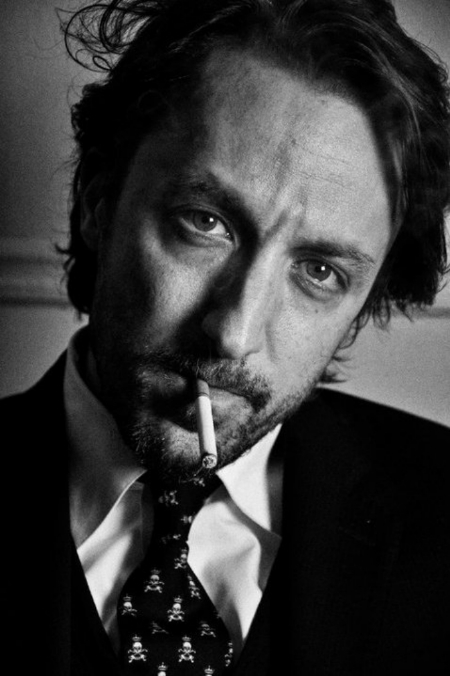Robert Banat The Hollow Bone
by Anthony Haden-Guest June 2015, New York
This is a very New York story so it’s a story in what can seem a bit overwhelmingly at times…the smallest great city in the world. Robert Banat spent many years managing restaurants, and not just any old restaurants either but Nobu, the Quilted Giraffe, the Four Seasons, Balthazar and Minetta Tavern, namely joints where eating out is considered a significant experience. But eight years ago that stopped being enough. “I’d been photographing for several years and studied photography. I was only shooting black and white film.” Banat says. “I hadn’t been showing my work, but I decided I had to make a change,” He was managing at Minetta Tavern at the time, a Keith McNally restaurant.” I spoke to Keith about it. He was very generous. He said, “You can always come back.”
Banat continued to do his stuff on and off at restaurants, as he plugged away at picture taking. He had become friendly with a number of regular customers, and some asked to see his photographs. John Newsom, the painter, liked what he saw. “He had an eye,” Newsom says. “And I knew he had a very unique talent with people” Newsom asked him to shoot a series of portraits of artists for a book project on which he was working. He should begin with Ross Bleckner.
“I called Ross and he said “Sure!” says Banat. “I got there fifteen minutes early, sweating! How am I going to do this? I was so nervous. So I became invisible. I tried to remove myself. I only spoke to him when he spoke to me. I was there for over three hours, like a fly on the wall.“
Bleckner remembers the shoot well, “First of all I knew he was very talented. I just knew,” he said. “There’s so much clarity. The optimism, the enthusiasm is contagious. There aren’t that many people around like that anymore.” That picture appears in Bleckner’s monograph "The Flower Paintings of Ross Bleckner" and it was effectively there that this long-haul project began. It has been an art journey that grew with its own making. “The main thing is that I feel fortunate to be in the space where an artist is creating work,” Banat says. “It’s a very intimate space. Most times when an artist is putting a brushstroke on canvas I’m the only person to witness that. I enjoyed my restaurant experience but when an artist is sharing that space with me everything seems to make sense to me. It’s a wonderful experience of being alive. Afterwards Ross told me you’re in this piece and several artists have said that I’m in the work somehow.”
The artist/photographer situation has been known to become prickly, as most notoriously with Jackson Pollock and Hans Namuth…a dinner table was upended and I asked a few artists Banat had photographed how the session went. “He is interested in helping the work. And staying out of the way,” says Rachel Rossin. “I was talking and painting and then I dropped the conversation because I was immersed in a thought about something I wanted to change. We were completely quiet for a significant amount of time. He’s lovely to work with.”
Ray Smith has known Banat from his restaurant days. “He’s about,” Smith says. “He’s a New Yorker. Then he starts to take photographs and he’s in studios, he’s part of the family, he was always there, and he became part of it. He’s inside the events, he’s not just a photographer, he connects with the artists and he starts accumulating a great body of work. He has a childlike quality, a sense of wonder. Not a jaded view. Not the jaded view that WE all have.”
Which gets pretty close to Banat’s own sense of what he’s doing. I asked whether there had been light-bulb moments. He described the different energies of specific session. As with Herman Nitsch.” He had a team of people working with him,” he said. “He had a pig slaughtered and the innards were laid on the table. It was a very hypnotic thing. You could feel the almost psychotic energy, with the people there getting into a very altered state.”
Ross Bleckner? Rather different. “He’ll take one brush, he’ll make one stroke and he’ll immediately clean that brush, place it back on the table. With a roll of paper under his arm, so he can continuously clean the brushes. Ross I think has a wonderfully surgical approach to his work.
“Throughout this project there have been a lot of Aha! moments. I feel I am doing what I should be doing and this all ties back to my studies of Joseph Campbell. He wrote, “The Shamans of the past are the Artists of today.” There’s a connection to something bigger and greater that existed before them, and will continue to exist. It’s a nice place to be, this is just one phase in an ongoing process. This is a life project for me.”
Anthony Haden-Guest photo courtesy of Robert Banat
Info
Robert Banat is a Photographer living in New York City.
RobertBanat@gmail.com
Copyright
All images appearing in the Robert Banat Photography web site are the exclusive property of Robert Banat and are protected under the United States and International Copyright laws.
The images may not be reproduced, copied, transmitted or manipulated without the written permission of Robert Banat.
Use of any image as the basis for another photographic concept or illustration (digital, artist rendering or alike) is a violation of the United States and International Copyright laws. All images are copyrighted © Robert Banat.
The Hollow Bone Installation at Ray Smith Studio. June 4th, 2015 Brooklyn, New York




